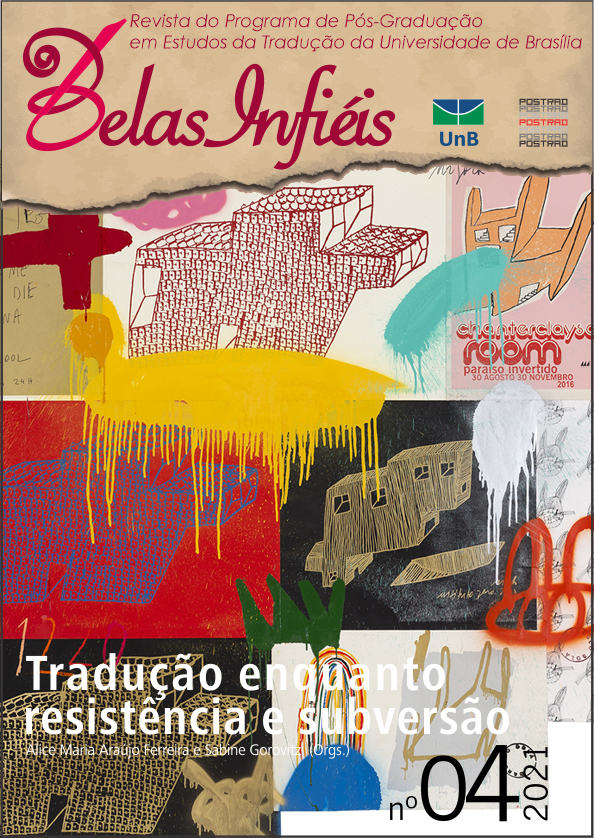O bardo vai a Bollywood: Hamlet e Haider entre espelhos
DOI:
https://doi.org/10.26512/belasinfieis.v10.n4.2021.34249Palavras-chave:
William Shakespeare. Hamlet. Adaptação fílmica. Bollywood. Vishal Bhardwaj. Caxemira.Resumo
Este artigo discute o filme indiano Haider (2014), de Vishal Bhardwaj, que é uma adaptação da peça Hamlet (1604-5/2016), de William Shakespeare, e do romance Curfewed Night (2008), de Basharat Peer. Haider torna as lutas políticas da Caxemira na década de 1990 um espelho para os conflitos presentes no Hamlet elisabetano. Buscamos identificar na obra de Bhardwaj algumas das motivações políticas, culturais e estéticas que podem estar intrinsecamente relacionadas à reescrita indiana. Ao traçar alguns dos marcos culturais e das mudanças narrativas entre a peça e o filme, nossa análise tenta enfatizar que os contextos sociais e culturais, além dos aspectos linguísticos-textuais, são essenciais na criação das reescritas.
Downloads
Referências
Almereyda, M.; & Matthews, D. (2009). Foreword: “The skeleton in the mirror”. In M. W. Driver & S. Ray (Eds.), Shakespeare and the Middle Ages: essays on the performance and adaptation of the plays with medieval sources or settings (pp. 1-6). McFarland & Company.
Bashir, A. (2010, 11 outubro). Kasmir’s half-widows shoulder the burden of a double tragedy. The Guardian. https://www.theguardian.com/global-development/2010/oct/11/1.
Bassnett, S., & Lefevere, A. (1990). Introduction: Proust’s grandmother and the Thousand and One Nights: The ‘Cultural Turn’ in Translation Studies. In A. Lefevere & S. Bassnett (Eds.), Translation, History and Culture (pp. 1-13). Pinter.
Bastin, G. (2001). Adaptation. In M. Baker (Ed.), Routledge Encyclopedia of Translation Studies (2nd ed., p. 5-8). Routledge.
Bhardwaj, V. (Diretor). (2014). Haider [Filme]. VB Pictures.
Bhardwaj, V., & Peer, B. (2014). Haider: the original screenplay with English translation. Harper Collins.
Chaudhuri, S., & Lim, C. S. (2006). Introduction. In S. Chaudhuri & C. S. Lim (Eds.), Shakespeare without English: the reception of Shakespeare in non-anglophone countries (pp. vii-xvi). Pearson Longman.
Das, P. (2012, jul./dez.) Shakespeare's Representation of Women in his Tragedies. Prime University Journal, 6(2), 37-56. https://www.primeuniversity.edu.bd/070513/journals/v_6_n_2_J_D_2012/contents_pdf/04_Prime_University.pdf
Das, S. K. (2005). Shakespeare in Indian Languages. In: P. Trivedi & D. Bartholomeusz (Eds.), India’s Shakespeare: translation, interpretation, and performance (pp. 42-65). University of Delaware Press.
Devika & Gupta, P. (2015, jan./jun.). Studies in aesthetic delight (Parmananda) in Hindi film adaptations. The NEHU Journal, XIII (1), 1-20. http://dspace.nehu.ac.in/jspui/bitstream/123456789/12932/1/JournalVolXIII_Jan_June%202015_Art1.pdf.
Dickson, A. (2016, 28 junho) Andrew Dickson: Worlds Elsewhere: Journeys Around Shakespeare's Globe. British Council Literature. https://literature.britishcouncil.org/blog/2016/andrew-dickson-worlds-elsewhere-journeys-around-shakespeares-globe/.
Dobson, M. (2015, 16 setembro). What makes Shakespeare endlessly adaptable. Voices Magazine. https://www.britishcouncil.org/voices-magazine/what-makes-shakespeare-endlessly-adaptable.
Donaldson, A. (2016). All the world’s: how Shakespeare is viewed around the globe and the role his work can play to support the UK’s soft power. British Council. https://www.britishcouncil.org/sites/default/files/all_the_worlds.pdf.
Doshi, V. (2016, 8 outubro). India grants divorce to man whose wife refused to live with in-laws. The Guardian. https://www.theguardian.com/world/2016/oct/08/india-divorce-man-cruelty-western-thought-in-laws.
Faulwetter, K. (2018. 23 agosto). Global Shakespeare: translating iambic pentameter. MotaWord. https://de.motaword.com/blog/famous-translators/william-shakespeare.
Garcia-Periago, R. M. (2014). The ambiguities of Bollywood conventions and the reading of transnationalism in Vishal Bhardwaj’s Maqbool. In C. Dionne & P. Kapadia (Eds.), Bollywood Shakespeares (pp. 63-86). Palgrave Macmillan.
Guy, J., Hunt, K., Kumar, N., & Regan H. (2019, 28 fevereiro). Why Kashmir means so much to both India and Pakistan. CNN. https://edition.cnn.com/2016/09/30/asia/kashmir-explainer/index.html.
Hall, E. T. (1990). The Hidden Dimension. Anchor Books.
Huang, A. C. Y. (2006). Shamlet: Shakespeare as a palimpsest. In S. Chaudhuri & C. S. Lim (Eds.), Shakespeare without English: the reception of Shakespeare in non-anglophone countries (pp. 21-47). Pearson Longman.
Hunt, K. (2016, 30 setembro). India and Pakistan's Kashmir dispute: What you need to know. The Oklahoman. https://oklahoman.com/article/feed/1084343/india-and-pakistans-kashmir-dispute-what-you-need-to-know.
Hutcheon, L., & O’Flynn, S. (2013). A Theory of Adaptation (2nd ed.). Routledge.
Ingham, M. (2008). Following the dream/passing the meme: Shakespeare in ‘translation’. Studies in theater and performance. [Special issue], 28(2), 111-126.
Kapadia, P. (1997). Bastardizing the bard: appropriations of Shakespeare’s plays in post-colonial India. University of Massachusetts Amherst].
Kumar, A. (2016, 23 maio). I am not a leftist, I am not an artist. The Hindu. https://www.thehindu.com/features/metroplus/if-i-am-not-a-leftist-i-am-not-an-artist-vishal-bhardwaj/article6471437.ece.
Lefevere, A. (1992). Translation/History/Culture: a sourcebook. Routledge.
Lefevere, A. (2017). Translation, Rewriting and the Manipulation of Literary Fame. Routledge. (Trabalho originalmente publicado em 1992)
Office of the Registrar General. (2011). Census of India 2011. New Delhi: Office of the Registrar General. https://censusindia.gov.in/2011Census/C-16_25062018_NEW.pdf.
Peer, Basharat. (2008). Curfewed Night. Random House India.
Rodgers, A. (2016). Vishal Bhardwaj. Shakespeare Bulletin, 34(3), 500-504. doi:10.1353/shb.2016.0041.
Sanders, J. (2006). Adaptation and appropriation. Routledge.
Sarkar, A. (2016). Haider and the Nation-State: Shakespeare, Bollywood, and Kashimir. South Asian Review, 37(2), 29-46.
Shakespeare, W. (1604-5/2016). Hamlet. (The Arden Shakespeare, Ann Thompson and Neil Taylor, Eds.). Routledge.
Shakespeare, W. (1623/1998). Hamlet. In Mr. William Shakespeares comedies, histories, and tragedies: a facsimile of the first folio, 1623. (Doug Moston, Ed.). Routledge, pp. 152-282.
Shirsat, P. (2017). The chronicle of caste and the medical profession in India. IOSR Journal of Humanities and Social Science, 22(9), 65-69. http://www.iosrjournals.org/iosr-jhss/papers/Vol.%2022%20Issue9/Version-1/G2209016569.pdf.
Singh, H. (2014, 5 outubro). ‘Kashmir is the Hamlet of my film,’says Vishal Bhardwaj on Haider – An interview with Vishal Bhardwaj. The Indian Express. https://indianexpress.com/article/entertainment/bollywood/kashmir-is-the-hamlet-of-my-film/.
Singh, J. (1989). Different Shakespeares: The Bard in Colonial/Postcolonial India. Theatre Journal, 41(4), 445-458. www.jstor.org/stable/3208007
Sreekanth, A. (2016, 30 outubro). The ill-named item number. Berkeley Political Review. https://bpr.berkeley.edu/2016/10/30/the-ill-named-item-number/.
Tigner, A. L. (2012). Literature and the Renaissance Garden from Elizabeth to Charles I: England’s paradise. Ashgate.
Trivedi, P. (2019). Woman as avenger: ‘Indianising’ the Shakespearean Tragic in the Films of Vishal Bhardwaj. In P. Trivedi & P. Chakravarti (Eds.), Shakespeare and Indian cinemas: ‘Local Habitations’ (pp. 23-44). Routledge.
Trompenaars, F., & Hampden-Turner, C. (1997). Riding the waves of culture: understanding cultural diversity in business (2nd ed.). Nicholas Brealey Publishing.
Umar, B. (2013, 12 outubro). The dilemma of Kashmir’s half-widows. Aljazeera. https://www.aljazeera.com/news/asia/2013/09/dilemma-kashmir-half-widows-201392715575877378.html.
Vats, V. (2014, 27 outubro). Bollywood Takes on the Agony of Kashmir, Through Shakespeare. The New York Times. https://www.nytimes.com/2014/10/28/arts/international/in-haider-vishal-bhardwaj-draws-from-hamlet.html.
Walsh, B. (2018). Resisting Hamlet: Revenge and Nonviolent Struggle in Vishal Bhardwaj’s Haider. Literature Film Quarterly, 46(2). https://lfq.salisbury.edu/_issues/46_2/resisting_hamlet_revenge_and_nonviolent_struggle_in_vishal_bhardwajs_haider.html.
Downloads
Publicado
Como Citar
Edição
Seção
Licença
Copyright (c) 2021 CC BY

Este trabalho está licenciado sob uma licença Creative Commons Attribution 4.0 International License.
Dado ao acesso público desta revista, os textos são de uso gratuito, com obrigatoriedade de reconhecimento da autoria original e da publicação inicial nesta revista
A revista permitirá o uso dos trabalhos publicados para fins não comerciais, incluindo direito de enviar o trabalho para bases de dados de acesso público. As contribuições publicadas são de total e exclusiva responsabilidade dos autores.
Os autores, ao submeterem trabalhos para serem avaliados pela revista Belas Infiéis, mantêm os direitos autorais e concedem à revista o direito de primeira publicação, sendo o trabalho licenciado sob a Creative Commons Attribution License Atribuição 4.0 Internacional (CC BY 4.0).



















